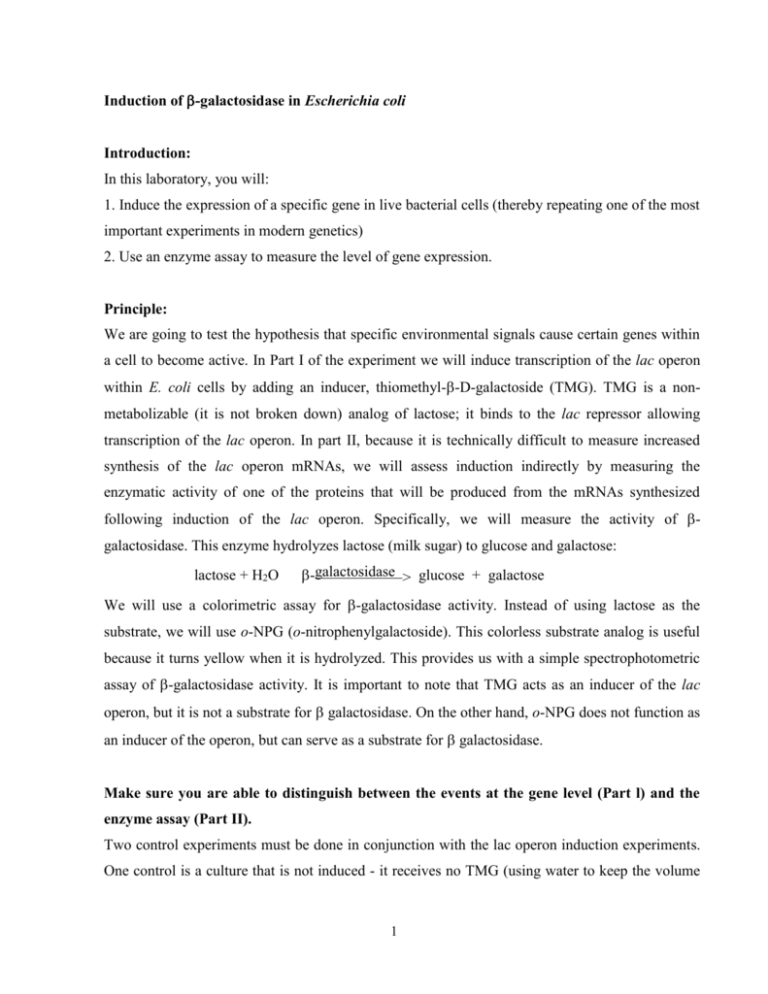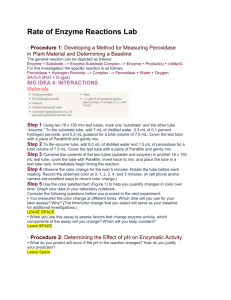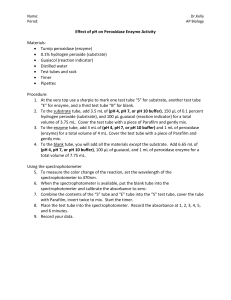Induction of b-galactosidase in Escherichia coli Introduction: In this
advertisement

Induction of -galactosidase in Escherichia coli Introduction: In this laboratory, you will: 1. Induce the expression of a specific gene in live bacterial cells (thereby repeating one of the most important experiments in modern genetics) 2. Use an enzyme assay to measure the level of gene expression. Principle: We are going to test the hypothesis that specific environmental signals cause certain genes within a cell to become active. In Part I of the experiment we will induce transcription of the lac operon within E. coli cells by adding an inducer, thiomethyl--D-galactoside (TMG). TMG is a nonmetabolizable (it is not broken down) analog of lactose; it binds to the lac repressor allowing transcription of the lac operon. In part II, because it is technically difficult to measure increased synthesis of the lac operon mRNAs, we will assess induction indirectly by measuring the enzymatic activity of one of the proteins that will be produced from the mRNAs synthesized following induction of the lac operon. Specifically, we will measure the activity of galactosidase. This enzyme hydrolyzes lactose (milk sugar) to glucose and galactose: lactose + H2O -galactosidase > glucose + galactose We will use a colorimetric assay for -galactosidase activity. Instead of using lactose as the substrate, we will use o-NPG (o-nitrophenylgalactoside). This colorless substrate analog is useful because it turns yellow when it is hydrolyzed. This provides us with a simple spectrophotometric assay of -galactosidase activity. It is important to note that TMG acts as an inducer of the lac operon, but it is not a substrate for galactosidase. On the other hand, o-NPG does not function as an inducer of the operon, but can serve as a substrate for galactosidase. Make sure you are able to distinguish between the events at the gene level (Part l) and the enzyme assay (Part II). Two control experiments must be done in conjunction with the lac operon induction experiments. One control is a culture that is not induced - it receives no TMG (using water to keep the volume 1 constant). The second control will be induced by TMG, but samples will not receive any substrate, o-NPG (using water to keep the volume constant), during the enzyme assay. The data from the control experiments will be shared among teams in order to compare the units of -galactosidase activity per cell from induced versus uninduced cultures. Experimental procedures A. Resuspension E. coli cells in minimal medium E. coli cultures were grown exponentially in a nutrient medium overnight. The nutrient medium will be replaced with a minimal salts solution. This type of medium lacks a carbon source; there are no sugars or amino acids that can be metabolized. In the absence of any carbon-containing nutrients, the number of cells in the E. coli suspension should remain constant. The instructor will centrifuge 35 ml aliquots of E. coli culture at 6000 Xg for 10 minutes and will distribute a tube containing the resulting bacterial cell pellet to each team. 1. Decant (pour out) the nutrient medium to the liquid waste beaker. 2. Resuspend the bacterial pellet in 25 ml of minimal salts medium by pipeting the culture up and down forcefully. The bacterial concentration should be about 4 x 109 cells/ml. B. Part I: Induction of the lac operon by TMG or TMG + glucose One team (Team 1) at each bench will carry out the induction experiment and the “Uninduced” control. The other team (Team 2) will carry out the induction experiment and the “No substrate” control. 1. Both Teams: Obtain 2 sterile disposable 50ml conical tubes and label them to identify your team. Label one tube “Induced”. The other tube should be labeled according to the control assigned to your team (“uninduced” or “no substrate”). 2. Using a disposable pipet, place 10 ml of the bacterial suspension in each conical tube. 3. Place the tubess of bacterial cultures in the 37°C shaking incubator for 5 minutes. 4. Note: It is important to carefully time and quickly complete the instructions for this step. Team 1: Add 1 ml of water to the “Uninduced” control tube and swirl to mix. Immediately remove a 1 ml sample from this flask and place in a test tube labeled “Uninduced/ 0 min.”. Immediately place the tube on ice. 2 Team 2: Add 1 ml TMG to the “No Substrate” tube and swirl to mix. Begin tracking time. Immediately remove a 1 ml sample from this flask and place in a test tube labeled “No Substrate/ 0 min.”. Immediately place the tube on ice. Both Teams: Add 1 ml TMG to the “Induced” tube and swirl to mix. Immediately after adding TMG, begin tracking time and remove 1 ml samples from each of these tubes. Place the samples in corresponding test tubes labeled “Induced/ 0 min”. Return all tubes to the 37°C shaking incubator. All samples of bacteria removed from the tubes during this and subsequent steps will be kept inactive on ice and then lysed (broken open) at the same time later in the experiment. The temperature (0°C) should inhibit further enzyme synthesis. 5. At 10 minutes after adding TMG, remove a 1 ml sample from each tube. Place the samples in the corresponding labeled test tubes (Uninduced/10 min, Induced/10 min, and No Substrate/10 min) and put the tubes on ice. Continue incubating the flasks in the 37°C shaking incubator. 6. At 20 min. after adding TMG, repeat Step 5. Label these tubes "20 min" and place them on ice. Continue incubating the flasks in the 37°C shaking incubator. 7. At 40 min. after adding TMG, repeat Step 5. Label these tubes "40 min" and place them on ice. Continue incubating the flasks in the 37°C shaking incubator. 8. At 60 min. after adding TMG, repeat Step 5. Label these tubes "60 min". Place these samples on ice for 5 minutes. 9. After chilling the 60-minute samples, all the samples must be warmed up before adding sodium dodecyl sulfate (SDS). SDS precipitates in the cold. Place all tubes in a 37°C incubator for 5 minutes. 10. Add 100 µl SDS to each of the samples. Mix thoroughly. Place the tubes back in the 37°C incubator for an additional 5 minutes. SDS is a detergent that will lyse the cells and permit their contents to leak out. Enzymes such as -galactosidase must be released from the cell if their activity is to be assayed. 3 C. Part II. Enzyme Assay 1. To each sample (five tubes) of warmed, lysed cells in the “No substrate” control, add 100µl water. To all other samples of warmed, lysed cells, add 100 µl of 0.013 M (o-NPG). Mix thoroughly. Note the exact time at which it is added. 2. Incubate the samples at 37°C for 30 minutes. Terminate the reaction by adding 1 ml of 1 M Na2CO3 to each tube. Mix thoroughly. 3. Remove 1 ml from each sample and place in corresponding labeled microfuge tubes. Centrifuge the tubes at 13,000 rpm for 5 minutes. When you are ready to measure the absorbance, transfer the solution (be careful not to disturb the pellet) to a cuvette. Record the absorbance of the samples at 420 nm. Summary of Part I and Part II experimental procedures Induced Uninduced control No substrate control Incubate flask at 37° C, 5 min + 1 ml TMG or TMG + glucose Immediately remove 1 ml to 0’ tube, place on ice 10' at 37°C Remove 1 ml to 10’ tube, Place on ice Incubate flask at 37° C, 5 min + 1 ml H2O Immediately remove 1 ml to 0’ tube, place on ice Incubate flask at 37° C, 5 min + 1 ml TMG Immediately remove 1 ml to 0’ tube, place on ice 10' at 37°C Remove 1 ml to 10’ tube, Place on ice 10' at 37°C Remove 1 ml to 10’ tube, Place on ice Repeat sampling at 20, 40 and 60 minutes. Warm all tubes at 37°C for 3–4 min. Add the following to each tube: Induced Uninduced control No substrate control 0.1 ml SDS 5 min at 37°C 0.1 ml o-NPG 30 min at 37°C 1 ml Na2CO3 0.1 ml SDS 5 min at 37°C 0.1 ml o-NPG 30 min at 37°C 1 ml Na2CO3 0.1 ml SDS 5 min at 37°C 0.1 ml H2O 30 min at 37°C 1 ml Na2CO3 Centrifuge the samples. Measure absorbance at 420nm. 4 D. Calculations We want to express enzyme activity as units of activity (moles/min) per cell. In this system, a unit of enzyme activity is defined as that amount of enzyme that will hydrolyze 1 micromole of oNPG to yield 1 micromole of colored o-nitrophenol (o-NP) per minute. The following steps are to be performed for the “Induced” and “Uninduced” control. 1. Correction of A420 values: For each A420 value, subtract the A420 value for the “No substrate” control that was incubated for the corresponding time. These samples were assayed in Part II without o-NPG, so there will be no yellow color. The corrected absorbance values should represent only o-NP production. 2. Calculation of enzyme activity/tube: The formation of 1 micromole of product (o-NP) per tube corresponds to an increase in A420 of 0.008. Convert your A420 values to micromoles by dividing by 0.008. This tells you how many micromoles of o-NP were produced in each tube per 30-minute assay time. Divide this value by 30 to get units of enzyme activity. 3. Calculation of enzyme activity/cell: We estimate the bacterial concentration to be 4 x 109 cells/tube. Convert your enzyme activity values to units of -galactosidase per cell. 4. Plot your results as a function of time of induction. Use “time after addition of TMG (min)” on the x-axis and “units of enzyme activity per cell (micromoles of o-nitrophenol produced per cell per minute)” on the Y-axis. On the same graph, plot the results for both the induced and the uninduced cultures. Questions 1. Why do we need to prevent increase in bacterial number during our experiment? 2. Why is it preferable to use TMG rather than lactose as the inducer? 3. Why is o-NPG a better substrate for our purposes than lactose, the "natural" substrate? Are enzymes absolutely specific in their use of substrates? 4. What is taking place during the 30 minute incubation in step 2 of the Enzyme Assay? 5. Why does the addition of Na2CO3 terminate the reaction? 6. Do you expect to see any color development in the “Uninduced” control culture during the enzyme assays? Why or why not? 5 Assignment Hand in the following at the beginning of lab, week of 1. Table with values obtained at steps 1-3 of calculations for both induced and uninduced control cultures with appropriate title. 2. Graph of enzymatic activity/cell (Y-axis) vs time after addition of TMG (X-axis) for both the induced and the uninduced cultures with figure legend. 3. Answers to questions at the end of the handout 6






